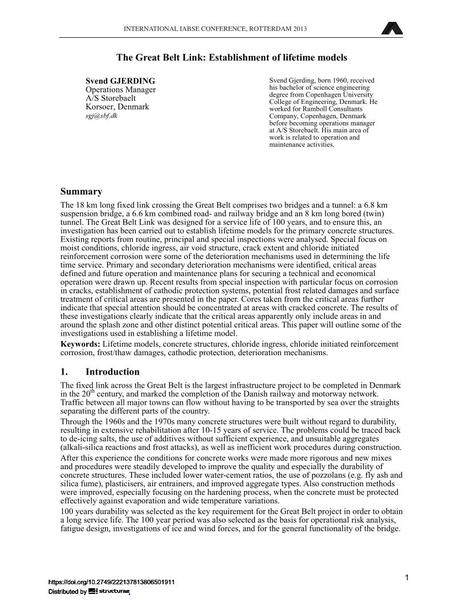The Great Belt Link: Establishment of lifetime models

|
|
|||||||||||
Bibliographic Details
| Author(s): |
Svend Gjerding
|
||||
|---|---|---|---|---|---|
| Medium: | conference paper | ||||
| Language(s): | English | ||||
| Conference: | IABSE Conference: Assessment, Upgrading and Refurbishment of Infrastructures, Rotterdam, The Netherlands, 6-8 May 2013 | ||||
| Published in: | IABSE Conference, Rotterdam, May 2013 | ||||
|
|||||
| Page(s): | 414-415 | ||||
| Total no. of pages: | 8 | ||||
| Year: | 2013 | ||||
| DOI: | 10.2749/222137813806501911 | ||||
| Abstract: |
The 18 km long fixed link crossing the Great Belt comprises two bridges and a tunnel: a 6.8 km suspension bridge, a 6.6 km combined road- and railway bridge and an 8 km long bored (twin) tunnel. The Great Belt Link was designed for a service life of 100 years, and to ensure this, an investigation has been carried out to establish lifetime models for the primary concrete structures. Existing reports from routine, principal and special inspections were analysed. Special focus on moist conditions, chloride ingress, air void structure, crack extent and chloride initiated reinforcement corrosion were some of the deterioration mechanisms used in determining the life time service. Primary and secondary deterioration mechanisms were identified, critical areas defined and future operation and maintenance plans for securing a technical and economical operation were drawn up. Recent results from special inspection with particular focus on corrosion in cracks, establishment of cathodic protection systems, potential frost related damages and surface treatment of critical areas are presented in the paper. Cores taken from the critical areas further indicate that special attention should be concentrated at areas with cracked concrete. The results of these investigations clearly indicate that the critical areas apparently only include areas in and around the splash zone and other distinct potential critical areas. This paper will outline some of the investigations used in establishing a lifetime model. |
||||
| Keywords: |
cathodic protection Concrete Structures Chloride ingress Lifetime models chloride initiated reinforcement corrosion frost/thaw damages deterioration mechanisms
|
||||
